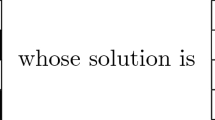Abstract
The neural network method of Hopfield and Tank claims to be able to find nearly-optimum solutions for discrete optimization problems, e.g. the travelling salesman problem. In the present paper, an example is given which shows that the Hopfield-Tank algorithm systematically prefers certain solutions even if the energy values of these solutions are clearly higher than the energy of the global minimum.
Similar content being viewed by others
References
Aarts EHL, Korst JHM (1987) Boltzmann machines and their applications. In: de Bakker et al. (eds) Parallel architectures and languages in Europe. Lecture Notes in Computer Science, vol 258. Springer, Berlin Heidelberg New York, pp 34–52
Aarts EHL, Korst JHM (1989) Simulated annealing and Boltzmann machines. Wiley, Chichester New York Brisbane
Angéniol B, de La Croix Vaubois G, le Texier J-Y (1988) Self-organizing feature maps and the Travelling Salesman Problem. Neural Networks 1:289–293
Cuykendall R, Reese R (1989) Scaling the neural network TSP algorithm. Biol Cybern 60:365–371
Duque Antón M, Kunz D (1990) Parallel algorithms for channel assignment in cellular mobile radio systems: The neural network approach. In: Eckmiller R et al. (eds) Parallel processing in neural systems and computers. North-Holland, Amsterdam New York Oxford, pp 441–444
Durbin R, Willshaw D (1987) An analogue approach to the travelling salesman problem using an elastic net method. Nature 326:689–691
Guez A, Kam M, Eilbert JL (1989) Computational-complexity reduction for neural network algorithms. IEEE Trans Syst Man Cybern SMC-19:409–414
Hopfield JJ (1982) Neural networks and physical systems with emergent collective computational abilities. Proc Natl Acad Sci USA 79:2554–2558
Hopfield JJ (1984) Neurons with graded response have collective computational properties like those of two-state neurons. Proc Natl Acad Sci USA 81:3088–3092
Hopfield JJ, Tank DW (1985) “Neural” computational of decisions in optimization problems. Biol Cybern 52:141–152
Kirkpatrick S, Gelatt CD Jr, Vecchi MP (1983) Optimization by simulated annealing. Science 220:671–680
Kohonen T (1984) Self-organization and associative memory. Springer Series in Information Sciences, vol 8. Springer, Berlin Heidelberg New York
Kunz D (1990a) Channel assignment for cellular radio using neural networks. IEEE Trans Veh Techn: (to be published)
Kunz D (1990b) Practical channel assignment using neural networks. 40th IEEE Veh Techn Conf, May 6–9, 1990, Orlando, FL, Proc. pp 652–655
Lin S, Kernighan BW (1973) An effective heuristic algorithm for the travelling-salesman problem. Oper Res 21:498–516
Ritter H, Schulten (1986) On the stationary state of Kohonen's self-organizing sensory mapping. Biol Cybern 54:99–106
Van den bout DE, Miller TK III (1989) Improving the performance of the Hopfield-Tank neural network through normalization and annealing. Biol Cybern 62:129–139
Wilson GV, Pawley GS (1988) On the stability of the Traveling Salesman algorithm of Hopfield and Tank. Biol Cybern 58:6370
Author information
Authors and Affiliations
Rights and permissions
About this article
Cite this article
Kunz, D. Suboptimum solutions obtained by the Hopfield-Tank neural network algorithm. Biol. Cybern. 65, 129–133 (1991). https://doi.org/10.1007/BF00202388
Received:
Accepted:
Issue Date:
DOI: https://doi.org/10.1007/BF00202388




